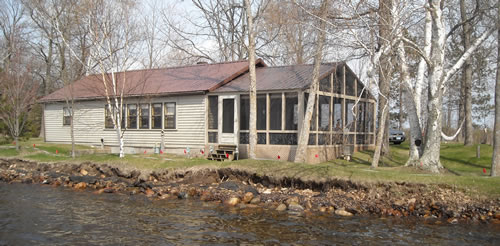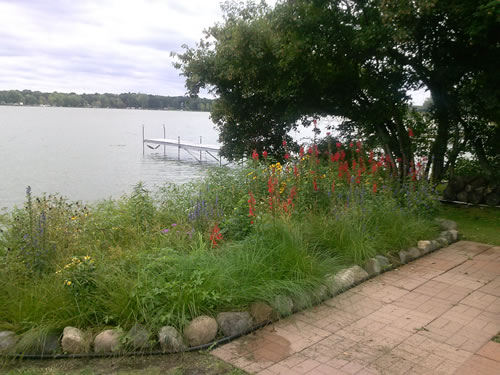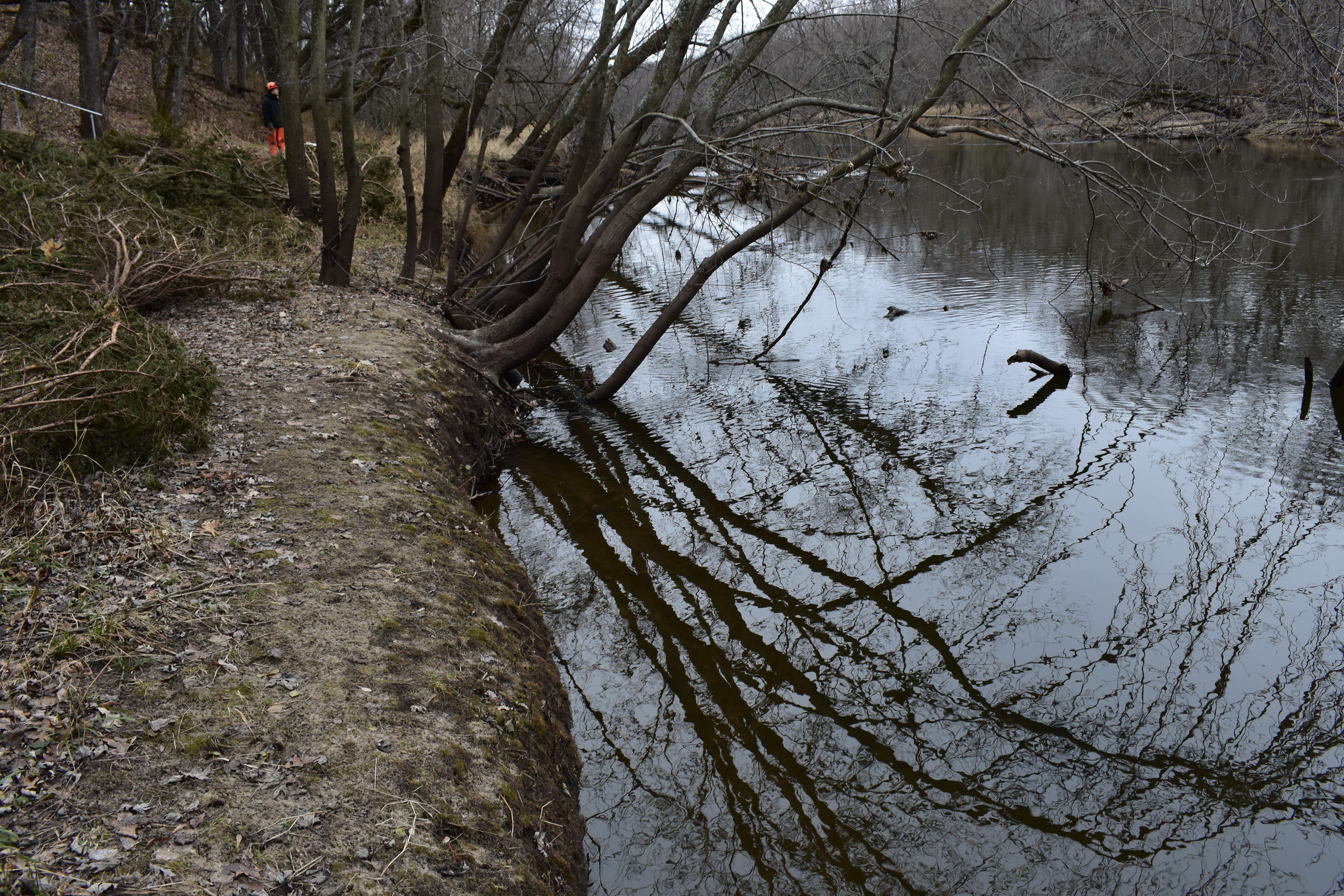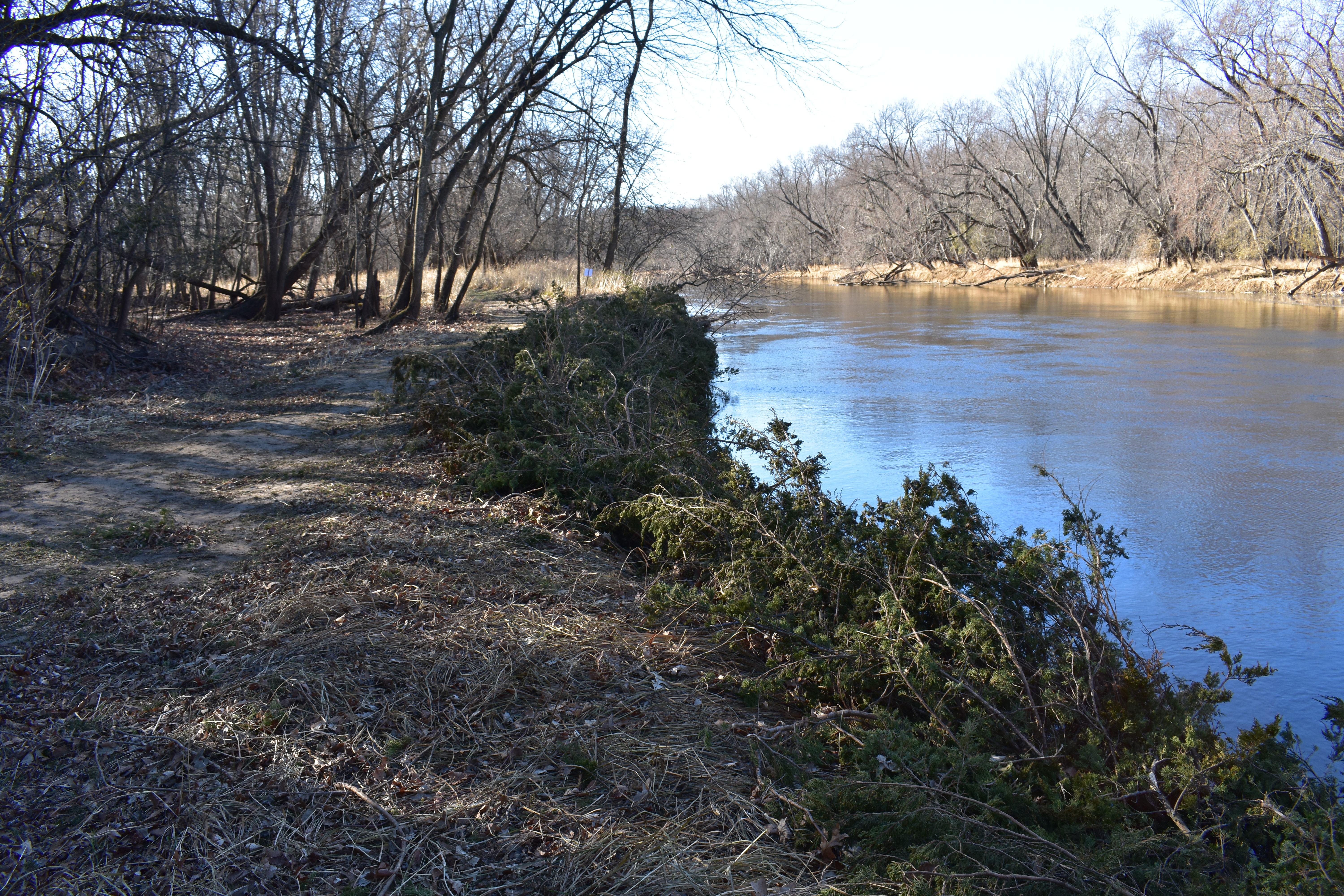Help for Shoreland Owners

The SWCD is able to provide technical assistance by making recommendations or providing design advice to reduce shoreland erosion on your property. We may also have funding available to assist with the costs of installing a project.
Lakeshore
Shoreline Restorations
As lakeshores are developed, many lakes throughout the county have had their native vegetation removed and replaced with manicured lawns. Traditional lawns lack the benefits of a natural shoreline and can exacerbate erosion. Lawns are shallow-rooted, provide little wildlife habitat, need frequent maintenance, and are often over-fertilized. These factors can lead to problems on your lakes, such as:

- Shoreline erosion
- Algae blooms
- Loss of wildlife habitat, but an increase in nuisance animals.
What is the solution? Install a native shoreland buffer!
A shoreland buffer is an area of native vegetation extending from the water's edge, ideally extending back at least 15 feet. The easiest way to create a lakeshore buffer is to simply not mow. You can also create a buffer by planting native grasses, wildflowers, and woody vegetation. Native plants are used because they have deep roots and are naturally suited to the environment. Contact Todd Kulaf with the Isanti SWCD for advice to get started at
Rain Gardens

Rain gardens are shallow basins planted with water-tolerant native plants designed to capture and filter runoff before it enters water bodies. Typically, they are strategically placed in areas that collect water from hillsides or impervious surfaces like driveways and sidewalks. By capturing runoff, rain gardens help protect water quality, prevent erosion caused by water channeling, and provide valuable habitat for pollinators.
Cost-Share Availability
The Isanti SWCD can provide technical and financial assistance to protect and improve water quality for projects such as rain gardens and shoreline restorations. Projects are prioritized for funding on a few merits, including water quality cost-benefit, location, funding availability, and more. They are funded up to 75% of the project cost.
Priority lakes with potential funding:
- Blue Lake
- Fannie
- Green Lake
- Long Lake (in Bradford)
- North Stanchfield
- South Stanchfield
- Skogman Lake
- Spectacle Lake
- Florence Lake (building an interest list)
To get started contact Todd Kulaf at 763-689-3271or
Helpful Resources:
- Who has regulatory authority in the Shoreland Zone? It depends where you live. Click here for guidance. We also have a contact list for common shoreline questions.
- Want to know what plants work well in a shoreline buffer?
- If you want to learn more about maintaining your shoreline project, here is a booklet that explains the suggested maintenance throughout the year.
- Information sheets discussing common shoreline alteration projects such as beach sand blanket and rip-rap can be found on the Blue thumb website. Blue Thumb is a public/private partnership that makes it easy for you to plan, purchase and plant lakeshore restorations! Check out their website! http://www.blue-thumb.org/
If you are interested in a lake shoreline erosion/stabilization project please contact: Conservation Technician Todd Kulaf at 763-689-3271 or
River Shore
Riverbank Stabilizations
Rivers and streams are not fixed landscape features. Over time their banks shift and move throughout a wider area called a floodplain which results in a natural level of erosion.
Erosion along a streambank can also be the result of human land use impacts (i.e. vegetation clearing, cropland, infrastructure…). Human activity along a stream or river can impact the natural buffer zone which can in turn increase the susceptibility to erosion. If the riparian area of a stream has been compromised, erosion can occur unchecked at unnatural levels, resulting in loss of property and decreased water quality that negatively affects aquatic animals such as fish.

Before restoration
What can I do if my streambank/river banks are eroding?
Determining what is causing erosion is the first step in addressing the concern. If multiple upstream sources cause the erosion, there is often little that a landowner can do to protect a streamside home other than extremely expensive and often temporary fixes. If the erosion is due to localized human activity such as clearing vegetation for cropland or a view, restoration efforts can frequently mitigate the erosion issue and restore the natural function of the shoreland areas. The function of shoreland areas includes bank stabilization, water quality protection, and fish and wildlife habitat.

Cedar trees staked in place to stabilize the riverbank.
Riverbank stabilization often combines bio-engineering with softer vegetative practices to create buffer zones along the waterway. The general concept relies upon restoring strong, rooted, woody vegetation. Woody vegetation protects streambanks in several ways:
- Root systems help hold the soil particles together, increasing bank stability
- Vegetation creates a rougher surface that can dissipate energy
- Woody vegetation on streambanks can induce sediment deposition and build banks
- Unlike rock, which transfers stream energy downstream, dense woody vegetation dampens the force and reduces downstream erosion
A variety of practices can be used to stabilize an eroding streambank, including but not limited to:
- Cedar Tree Revetments: Information Sheet
- Live staking: https://www.dnr.state.mn.us/rys/st/wattles.html
- Toe-wood Sod Mats: Stream Restoration: Toe Wood-Sod Mat
Click here to see our Completed Projects page for examples of Cedar Tree Revetments we have done. If you are interested in a riverbank/streambank stabilization project, please contact Tiffany Determan -
